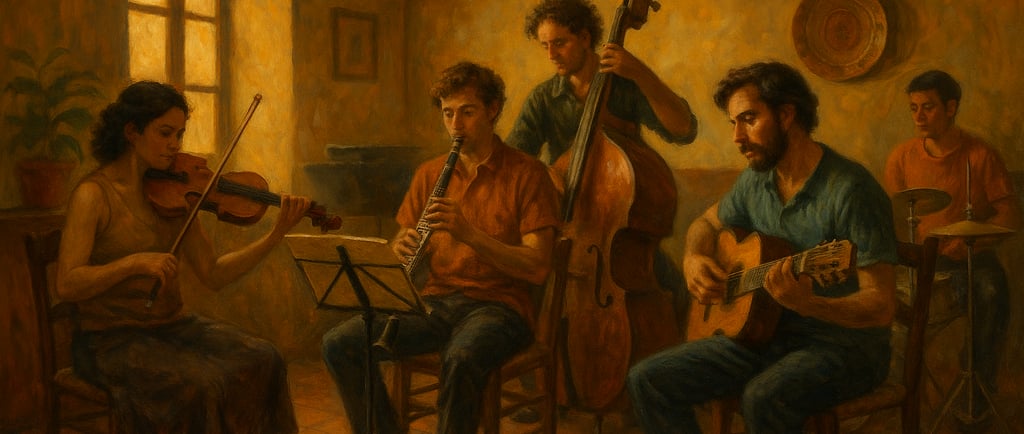Music in the Canary Islands: What Is Heard and What Is Sustained in Silence
This article examines the role of music in the Canary Islands as a living cultural practice and a source of community. It argues that culture is not sustained by major events alone, but by the everyday work of schools, ensembles, teachers, families, and local organizations. It calls for stronger investment in the foundational layers of the musical ecosystem to preserve identity, continuity, and cultural depth.


To speak of music in the Canary Islands is to speak of a shared history. A history that is not written only on stages or in large festivals, but in rehearsal rooms, in small classrooms, in town squares, in cultural associations, in homes where someone practices late at night, in conversations between those who live music not as entertainment, but as a way of being in the world.
Music is deeply rooted in the social experience of the islands. It is not merely repertoire or tradition: it is a living practice, continually reconstructed by those who carry it forward. As Raymond Williams wrote, “culture is a process, not a product” (Williams 1977, 64). In the Canary Islands, this process is built from encounters, intergenerational learning, daily effort, and a community structure that rarely appears in official cultural discourse.
A Cultural Fabric That Emerges from Below
When we speak of music, the focus is often placed on visible outcomes: symphonic seasons, renowned concerts, international festivals, awards, recognizable figures. All of this matters. Yet the true cultural architecture of the Canary Islands is sustained much earlier and much lower, in the everyday. It is sustained by the teacher who continues working after their official hours; by the bands that rehearse several times a week in modest shared spaces; by families who rearrange their routines to support musical vocations; by those who compose and arrange without knowing whether their works will be performed; by those who lead ensembles not from authority but from care. It is sustained as well by municipal music schools that quietly train entire generations, and by cultural associations that keep open spaces of meeting and belonging.
This effort is not secondary. It is foundational. Pierre Bourdieu expressed it clearly when he wrote that “art does not sustain itself in the void; it needs a field that recognizes it and gives it continuity” (Bourdieu 1993, 29). In the Canary Islands, that field is sustained above all by communities.
Cultural Policy Between the Visible and the Deep
In recent decades, cultural institutions in the Canary Islands have developed a notable program of public concerts and events. This has helped to project an image of strong cultural activity. However, programming alone does not guarantee sustainability. As Néstor García Canclini reminds us, “cultures are not sustained by exhibitions alone, but by educational and institutional continuity” (García Canclini 1999, 112).
Thus, the essential question arises: Are we supporting music as a process, or merely as spectacle?
Music does not originate on stage. It reaches the stage after years of learning, coexistence, and quiet work. If investment focuses only on what is publicly visible, the ecosystem weakens at its roots. In the Canary Islands, music is not only art: it is also community. Bands, choirs, and ensembles have, for generations, been spaces where people learn to listen to one another, to take responsibility, to share time and care. They are places where young people find mentors, where adults find purpose, where celebrations and mourning are accompanied. Culture does not take place only in auditoriums. It also happens in the hallway where stands are stored, in conversations after rehearsal, in the feeling of belonging shared among those who play, learn, or listen. This value, however, is rarely treated with the seriousness it deserves in cultural planning.
Identity as Movement
The Canary Islands are an Atlantic culture: shaped in dialogue, travel, openness, and mixture. Their music is not a repertoire to preserve untouched, but a living movement that continues to evolve. Reducing music to a tourist emblem or static folkloric symbol impoverishes it. Identity is not something displayed—it is something built continuously.
Caring for the Base: The Heart of Cultural Policy
María Zambrano wrote that “culture is sustained through care and listening” (Zambrano 1989, 17). If this is true—and it is—then the consequence is clear: if we truly believe that music is part of our cultural identity, we must invest in its foundation.
Not only in what is visible.
Not only in what can be photographed.
Not only in what produces immediate recognition.
But in accessible music education, community ensembles, contemporary creation, dignified teaching, safe rehearsal spaces, and continuity beyond electoral cycles.
I would say—and I do—that we must be coherent. If we affirm that music represents us, then investing in its foundation is not a gesture of support: it is a cultural responsibility. It is also, in a profound sense, a way of building homeland: not a homeland of exclusion, but one understood as a community that cares for itself through the culture that expresses and sustains it.
True culture is not what is shown when the lights are on.
It is what remains when the lights are gone.
And what remains—what continues, what persists—is precisely what we are called to protect.